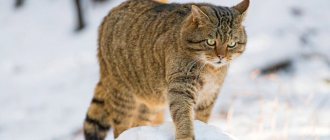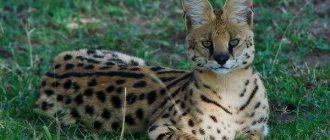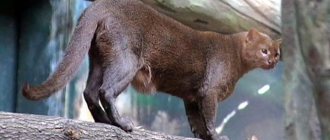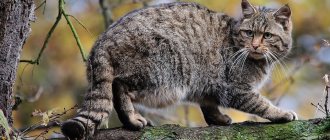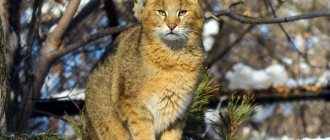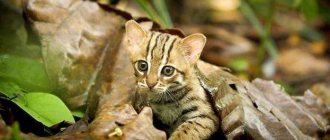The African black-footed cat is a desert animal that, despite its rather small size, is distinguished by its endurance and tough temperament. This predatory and ferocious representative of the cat family prefers to live separately from other animals.
This feline is the smallest and lightest among all its relatives. The black-footed cat is considered the most freedom-loving among the entire cat family. Scientists have discovered only two varieties of this breed. The first lives in the Kalahari Desert, the second has chosen grassy areas for its life.
Habitat
Under natural conditions, the black-footed cat lives exclusively in Africa, and not throughout the entire African continent, but only in southern countries. For their residence, these cats have chosen the arid and sparsely inhabited areas of the Kalahari Desert, where they feel quite comfortable, as they can go without water for a long time.
The black-footed cat's habitat is limited to several African countries. These are primarily Zimbabwe and South Africa. Representatives of this breed are also found in Botswana and Namibia.
The black-footed cat prefers to settle in dry, flat areas and lands covered with rare grasses and shrubs, where, thanks to their camouflage color, these cats feel quite confident.
Black-footed cat in the wild
The behavior of the African wild cat in natural conditions remains largely a mystery to researchers. This is a small but striking representative of the amazing fauna of the hottest continent.
Habitats
The black-footed cat lives compactly in the very south of South Africa in desert and semi-desert regions. It also lives in the mountains, but usually does not rise above two thousand meters above sea level. The animal is found in four countries bordering each other: Angola, Botswana, Zimbabwe and Namibia.
The black-footed cat lives compactly in southern Africa
There are two subspecies of the black-footed cat: Felis nigripes nigripes has a lighter color and lives mostly in deserts, and Felis nigripes thomas, distinguished by its contrasting and bright color, lives mainly in grassy savannas.
In most territories, the wild cat is protected by national legislation; hunting it is prohibited, as is unofficial export outside the continent. The black-footed cat is listed in the CITES Convention and the International Red Book. However, rules and prohibitions are still violated quite often.
A wild cat prefers not to meet a person - his main enemy
The habitat of the black-footed cat remains unchanged, but its population is constantly decreasing. Human economic activity has a negative effect on the population of the species. Many animals die from poisoning from poisons used in agriculture; wild cats often fall into traps set by humans for other types of predators.
Lifestyle
Outwardly, the black-footed cat is very similar to the cute domestic purr, but the first impression in this case is wrong. The charming little animal is in fact a cruel and very active predator, which has absolutely no complexes about its small size, and is distinguished by its ferocity and rare fearlessness. Black-footed cats lead a secretive and solitary lifestyle - they hide in shelters during the day and go hunting at night.
The black-footed cat often hunts from ambush
They adapt the burrows of other animals—most often rabbits—for housing. Just don’t ask where the previous owners went. Sometimes cats even settle in abandoned termite mounds. The hunting grounds of each animal are strictly individual, and their boundaries are strictly observed. The personal territory of a female can be up to ten square kilometers, while that of a male is twice as large.
The little predator has perfectly adapted to life in a hot and dry climate. For example, she is able to go without water for a long time, obtaining the necessary liquid from food. This cat is very hardy and tireless. Going out to hunt at dusk, it moves long distances in search of prey and can walk more than ten kilometers during the night. At the same time, the animal kills significantly more small animals and birds than it can eat. He buries the surplus of hunted game, marking the places of hidden supplies.
The black-footed cat is the ideal hunter
The diet of the wild African cat is based on various rodents and birds, but sometimes it successfully hunts animals that are several times larger than itself - for example, small antelopes. The black-footed cat's diet includes up to sixty species of a wide variety of animals. This predator can eat reptiles, insects, and carrion, but most of all, of course, it loves fresh meat.
Aborigines love to tell impressionable tourists stories about how this small but bloodthirsty predator kills giraffes by biting their jugular vein. But these, of course, are nothing more than local legends for visitors. However, it is a reliable fact that black-footed cats sometimes hunt ostriches - and such attacks are almost always successful.
Even large predators try not to mess with this lawlessness
Natural enemies of the wild African cat can be both snakes and large predators. Although the latter, knowing the desperate and courageous disposition of the black-footed cat, usually prefer not to get involved with it - unless they decide to attack the cubs who are briefly left without a mother.
Video: black-footed cat in its natural habitat
Reproduction and care of offspring
When females come into a state of hunting, they mark their territory and thereby give a sign to the suitors. Future parents pair up briefly . Their love games do not last long, no more than two or three days, and then the male leaves his girlfriend, leaving her with all the joys of caring for the offspring.
Soon after mating, the cat begins to look for places for a den - most often it equips rabbit holes for this. The peculiarity of this predator is that it always has several spare options for its nest. Every few days she moves the cubs to a new hole, apparently changing the location of the den for safety reasons.
All care for the offspring falls on the mother cat
The pregnancy of a black-footed cat lasts two months or slightly longer. There are most often two kittens in a litter, but usually no more than four. The weight of a newborn, almost hairless, blind and deaf baby does not exceed eighty grams. The mother feeds the cubs with milk until the age of two months, but from about three weeks of age she begins to feed them meat.
Like all small wild cats, the young of this species mature very quickly. Already from the age of three weeks, kittens, suspecting danger, leave the den and hide, camouflaging themselves outside of it. By five months, children grow to their mother's size and begin to hunt independently . Soon after, they begin to live independently. But these animals are fully formed and become sexually mature only after a year.
Kittens of this species grow up very quickly
Video: black-footed cat kitten on a walk
Appearance
As mentioned above, the black-footed cat is a small animal. Males that have reached sexual maturity have a body not exceeding fifty centimeters in length. Adult females are even smaller, their body length barely reaches forty centimeters.
Despite the fact that this breed is called black-footed, in reality, the paws of these cats have the same sandy color as the body; only the feet of the animal are painted black.
- Typically, the tail of a black-footed cat is relatively long, and can range from ten to twenty centimeters in length.
- The wild black-footed cat also weighs little; the weight of adult individuals barely exceeds one and a half kilograms.
- The body of these cats is strong and muscular, with short but strong legs.
- The color of cats is inconspicuous, olive-grayish in color, with dark spots scattered throughout the body. In some parts of the body, the spots combine to form peculiar stripes, thereby giving the cat a resemblance to a leopard.
- The black-footed cat has a thick coat with short, shiny fur. When winter comes to African countries, the color of cats becomes somewhat paler, so it is easier for them to blend into the sandy desert plain.
- Cats have a large, round head, slightly tapering in the front.
- On the wary but cute face of the animal, the eyes especially stand out - large, slightly slanted, shining with a mystical, bright yellow color.
- Between the pads of cats' toes there are tufts of hair that prevent the animal from burning its paws on the hot desert sand.
Distinctive features of the black-footed cat
The African black-footed cat (Felis nigripes) is rightfully considered the smallest wild representative of its family. Adults weigh up to one and a half kilograms, and their body length does not exceed half a meter.
The camouflage color of the wild African cat perfectly camouflages the predator against the backdrop of sand and sparse vegetation. The fur coat of this cat is sand-colored and painted with dark spots and stripes. The shiny coat is coarse and short. On the paws the stripes form rings; The cat's legs are completely black underneath, which is where its name comes from. Tufts of dense wool protect the paw pads from the hot sand.
Black bracelets and “slippers” on the paws determined the name of this cat
The animal's body is strong and stocky, its round head is crowned with small, very sensitive ears; The greenish eyes are large, unusually expressive, although they look unkindly.
At night, the black-footed cat's eyes glow with an unusual blue light - she sees perfectly in the dark.
In the dark, the eyes of a wild cat shine with an infernal blue light
Lifestyle
Nature has tried to compensate for the small stature of African black-footed cats, and generously rewarded the miniature creatures with such traits as endurance and the ability to adapt to the harsh terrain of the African desert. Cats have both hypersensitive hearing and extremely acute vision, which is important given the lifestyle that these animals lead.
Like most predators, the black-footed cat hides during the day and comes out to hunt when darkness falls. These cats have all the qualities needed to hunt in wild desert areas, and the darkness of night is the ideal time to search for prey. Thanks to its endurance and ability to cover vast distances, a black-footed cat can travel up to twenty kilometers during a night hunt. Cats are unpretentious in their choice of prey; lizards, small rodents, such as gerbils or shrews, and even insects are suitable as food.
If the opportunity presents itself to attack larger prey, for example, a hare or a bustard, cats will definitely take advantage of this chance, and they are not stopped even by the fact that the chosen victim is significantly larger than them. If a cat is lucky enough to catch such a large prey, then they prudently bury the uneaten remains in the ground so that they can feast on the meat of a hare or bird the next day.
No less interesting is the method that black-footed cats use to search for and arrange their homes. They find abandoned termite mounds, anthills and burrows of aardvarks and porcupines, which abound in the African desert, and settle in almost finished houses. For this feature, local residents called the black-footed cat “ant tiger.”
Reproduction and care of offspring
Cats of this breed are not social animals and prefer to lead a solitary lifestyle. Each male chooses his own territory, which he carefully marks around the entire perimeter and jealously guards from strangers.
The possessions of females are more modest; most often they settle on the outskirts of the territories of males. What is noteworthy is that males are completely calm about the appearance of females in the area they protect.
Only when the mating season comes for these cats, which is the end of August, beginning of September, do the animals begin to search for a suitable partner. Females mark the ground and sparse bushes with their urine, letting the male know that they are ready to mate.
The courtship period does not last long, five to ten hours, after which the male gains the right to mate with the partner he likes. After this, the male leaves, not burdening himself with paternal feelings, and transfers all care of the future offspring to the female.
The pregnancy of a black-footed cat lasts for two to two and a half months. After this period, the cat gives birth to one or two babies. Kittens are born with virtually no fur and are completely blind.
With intensive feeding and care from the mother, the babies grow quickly, and after three weeks of age they are able to get out of the parental hole.
Interestingly, at the slightest danger, the kittens do not run to their mother’s den, but scatter throughout the territory, looking for suitable shelter, and leave it only after the mother’s call.
The female feeds the babies milk for one and a half months, and after this period, begins to transfer the kittens to adult food. After a night hunt, the mother brings live prey to the den, allowing the cubs to develop their hunting abilities from such a young age.
Grown-up kittens remain with their mother for up to three to four months, after which they begin an independent life in the harsh African terrain.
Characteristics of this breed
A characteristic feature of the black-footed cat is its amazing ability to go without water for a long time. Even in the driest periods, this cat can survive by getting all the moisture it needs from the prey it eats.
The extraordinary vitality and endurance of the black-footed cat has given rise to a lot of legends and traditions among the local aborigines. The Bushman tribes that share territory with these animals tell truly amazing stories about the aggression and hunting skills of black-footed cats. They believe that these predators are capable of attacking even a giraffe or an ostrich, which is undoubtedly a great exaggeration.
Care and maintenance in captivity
Some exotic animal lovers keep black-footed cats as pets. For those who nevertheless decide to place a representative of this breed in their home, they should remember that the African black-footed cat, a wild animal, is unlikely to get rid of its habits even at home.
Charming and playful kittens will eventually grow into real hunters and predators. These cats have an aggressive character, and in relation to the house and owner, they behave like big owners and jealous people. These cats will not tolerate the presence of other pets in the house. An exception may be if the animals grew up together from childhood.
A few words in conclusion
The black-footed cat has never been hunted by local tribes. But, due to the expansion of areas for crops and pastures for livestock, the natural habitat of these animals is catastrophically declining.
The African wild cat is also endangered because it often ends up in traps intended for other animals. To save the black-footed cat from extinction, its species is listed in the Red Book, and leading scientists and zoologists are making every effort to preserve this extraordinary and mysterious cat for future generations.
What else to see:
Nutrition and lifestyle
Black-footed cats live in old rabbit holes or abandoned termite mounds, which is why this breed is called the “ant tiger.”
During the day, predators use their protective coloration to hide from larger predators and poachers. And they prefer to hunt at night to hide from prying eyes.
These animals most often eat small mammals, especially gerbils. The main part of the diet of wild predators are jerboas, shrews, lizards and hares. Black-footed cats have an uncontrollable desire to hunt birds, and can sometimes even feast on bustards.
Large grasshoppers and even locusts often become their victims. If it is not possible to eat the prey at once, then the cat drags the remains into its hole, where it later returns.
